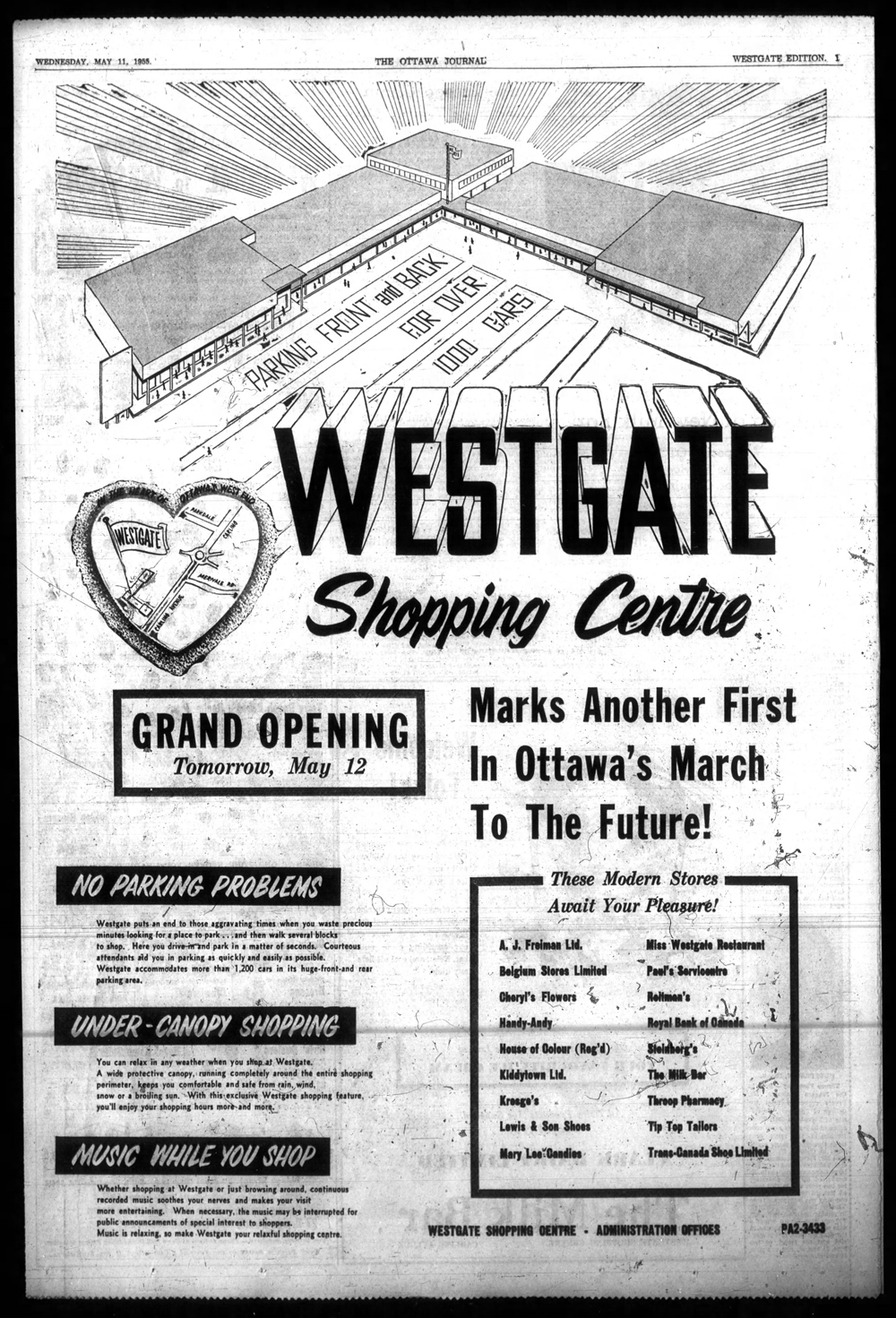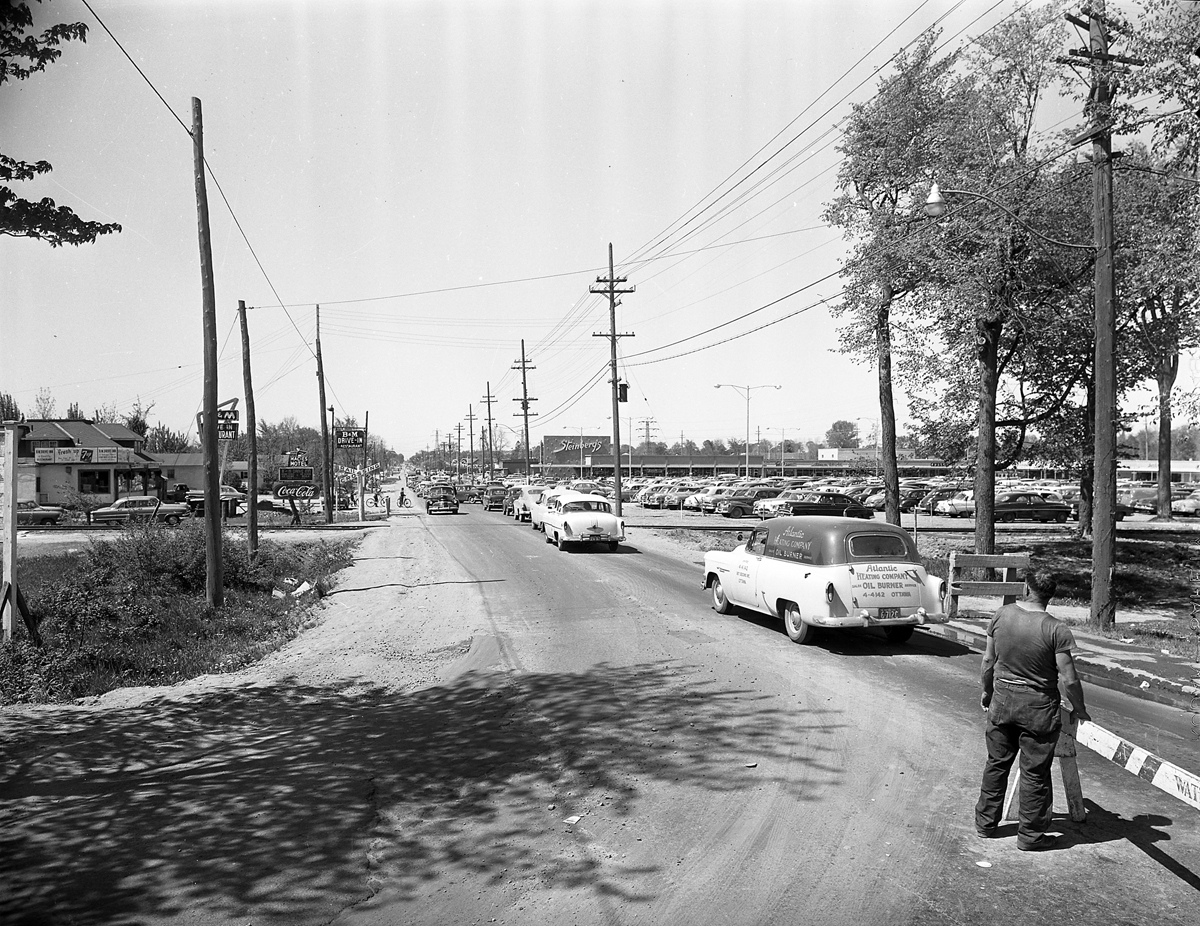By Dave Allston –
As Westgate Shopping Centre turns 60 years old this week, it is worth celebrating not only the long-standing success of Ottawa’s first and oldest mall, but also of local visionary Harold Shenkman.

The land on which Westgate would one day be built was forever an afterthought in the development of Kitchissippi. This forgotten triangle of land sat at the south end of the long Nepean Township lot 33 (the north end was Scott Street), as part of the desirable farm property that passed through the hands of such well-known local 19th century men as Robertson, Gilmour, Vankoughnet, Cowley, Holland and Brennan. This 200-acre farm was sought after for its proximity to Richmond Road, and particularly for the Convent mansion (built in 1861).
In 1892, the Ottawa, Arnprior and Parry Sound Railway ran their line through the southern end of lot 33, further isolating the Westgate triangle from the northern acreage. The railway would later become the GTR, then the CNR, and is now the Queensway, following its same path.
As time passed, the triangle sat vacant and valueless. It was largely marsh and bush. Half the property (depending on the time of year) was covered by Cave Creek, which ran all through Wellington Village and Mechanicsville to the river. It overflowed every year and caused huge issues in the neighbourhood until they put in drains in the late 20s.
J.R. Booth maintained his expansive lumber yards on the south side of Carling between Merivale and Fisher (the future area of homes for veterans), but otherwise there was little development in the area. Even the Hampton Park Ltd. development company subdivisions that were to come in the early 1900s would never stretch this far south.
It was not until the 1940s that Hampton Park would sell portions of their land fronting Carling. In 1942, well-known local homebuilder David Younghusband, purchased a parcel and built a storage building for his business (where Shoppers Drug Mart now exists); Wallace Barrington opened a Shell station to the west in 1942 (the station remained until the 1970s, directly behind the mall); and Sun Oil opened a competing service station in 1946 (about where the parking in front of Shoppers exists today). [story continues below photo]

It was in October of 1951 that real estate developer Harold Shenkman acquired his first parcel of Westgate land, purchasing the southeast corner for $21,000. A year later, in September of 1952, he purchased a large adjoining piece of land for $42,000. On that same day, he announced his intention to begin building a 25-store shopping mall – at a cost of $750,000 – which was to be completed by the spring of 1953.
His aspirations apparently grew during the winter. He held off on construction, and in June of 1953, purchased the Sun Oil and Younghusband properties with the ambition of opening an even grander mall on his now 12-acre site.
On April 1, 1954, Shenkman proclaimed that shovels were about to hit the ground for his mall, now slated to cost $2,000,000. One key factor in his expanded plan may have been the Federal District Commission’s plans to replace the now abandoned railway lines (the last train ran in 1952) with a new cross-town expressway, which would run directly to the mall (this of course, would become the Queensway).
Many thought Shenkman’s plan was foolish – that few would be interested in driving to what was then the outskirts of Ottawa to do their shopping. However, Shenkman’s vision would prove to be a success.
Construction ran throughout the winter of 1954-55 by contractors S.D. Millar and Sons of Montreal, following the plans of architect firm Eliasoph and Berkowitz, also of Montreal.
The official opening was held on May 12 although the first store to open was Steinberg’s grocery market on February 15. Steinbergs would remain until 1992, at which point it became a Your Independent Grocer. It is now a Shoppers Drug Mart.
The landmark occasion was not marked with a standard ribbon cutting, instead it was heralded with a futuristic radioactive gamma ray device designed by Canadian Aviation Electronics. This fell in line with the “Ottawa’s March To The Future” concept in their marketing. [story continues below photo]

Steinberg’s promoted “eight spacious aisles”, “14 efficient conveyer cash checkouts; one of them, for use in peak periods, is a mobile unit, and two express lanes”, and “music while you shop” as another “pleasing feature.”
Other stores began opening throughout March and April. They included Freiman’s, Reitman’s, Krege’s, Kiddytown, Royal Bank, Milk Bar, Throop Pharmacy, Handy-Andy, Chery’s Flowers, Tip Top Tailors, Paul’s Service Centre and others. The Miss Westgate Restaurant opened at this time and remained in business until June 1990, having been operated from beginning to end by Nusret “Mr. Ray” Bejkosalaj.
Westgate brought to Ottawa what was a burgeoning trend in American culture. Building on the rise in popularity of automobiles and suburban living, one-stop shopping centres gave consumers the opportunity to experience expanded, yet simpler shopping. For developers like Shenkman, they would use “anchor stores” like Freiman’s and Reitman’s, and the convenience of huge, free parking lots to draw large numbers of shoppers, which in turn expanded the customer base for the smaller chain or “Mom and Pop” stores that filled out the mall. What Westgate had over traditional commercial areas such as the Byward Market, Sparks Street and Bank Street was variety, convenience, and a trendy new shopping experience.
Shenkman sold the mall in February of 1960 and moved on to his next project, the Talisman Hotel on the opposite side of Carling.
Westgate was renovated extensively in the summer of 1978 with a $750,000 facelift to enclose the mall (with a facade of movable glass panels that could be opened in the summer), and the creation of a lower-level shopping area (with a dozen speciality shops), while Consumers Distributing opened upstairs, where they would remain until 1996.
Westgate Theatre opened as a three-screen cinema on November 14, 1980 on the mall’s second level. It closed July 23, 2000.
The mall transformed again during the winter of 1988-89 with a $2.3M renovation bringing the mall to a total of 50 stores. The 15,000 square foot expansion widened the mall with shops on two sides and added a food court. A further makeover occurred in 2004 with the arrival of Shopper’s Drug Mart.
So let us remember Mr. Shenkman and his foresight for west Ottawa. Let us celebrate the Westgate of yesterday and today as we fondly look back on the great shops and shopkeepers that have been a part of the lives of Kitchissippi residents for 60 years.
Dave Allston is a local history buff who publishes The Kitchissippi Museum. His family has lived in Kitchissippi for six generations. Send your Westgate memories to stories@kitchissippi.com and you may seem them in the next issue!